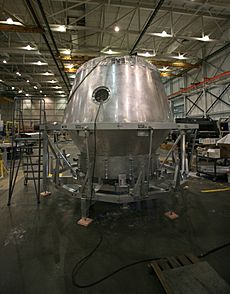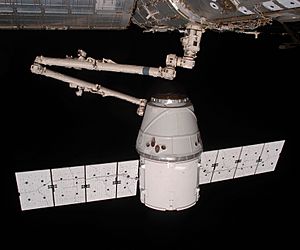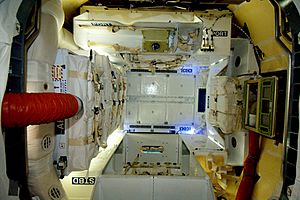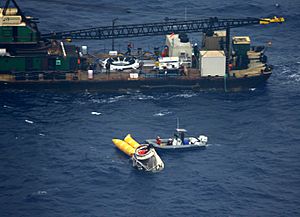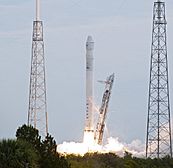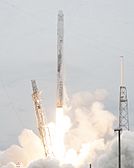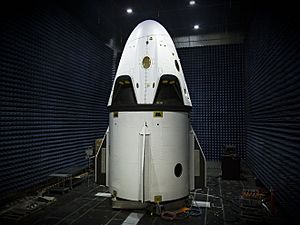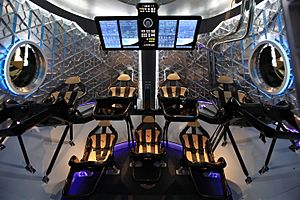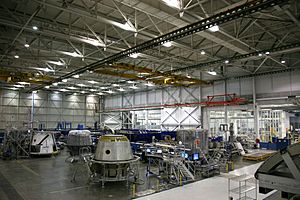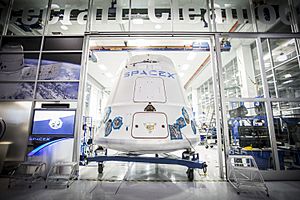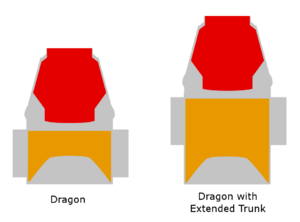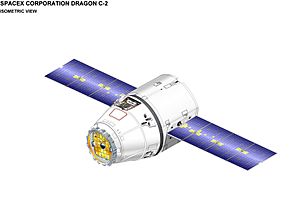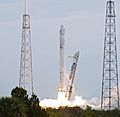SpaceX Dragon facts for kids
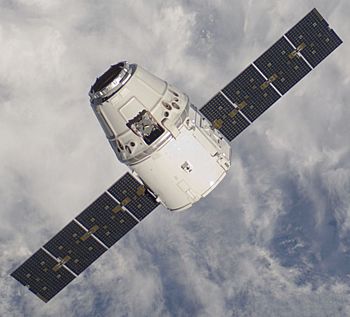
The SpaceX Dragon approaching the ISS during the C2+ mission in May 2012.
|
|||
| Manufacturer | SpaceX | ||
|---|---|---|---|
| Country of origin | United States | ||
| Operator | SpaceX | ||
| Applications | ISS logistics | ||
| Specifications | |||
| Dry mass | 4,201 kilograms (9,262 lb) | ||
| Payload capacity | to ISS 6,000 kilograms (13,000 lb), which can be all pressurized, all unpressurized or anywhere between. It can return to Earth 3,500 kilograms (7,700 lb), which can be all unpressurized disposal mass or up to 3,000 kilograms (6,600 lb) of return pressurized cargo | ||
| Crew capacity | 0 | ||
| Volume | 10 cubic metres (350 cu ft) pressurized 14 cubic metres (490 cu ft) unpressurized 34 cubic metres (1,200 cu ft) unpressurized with extended trunk |
||
| Dimensions | |||
| Length | 6.1 metres (20 ft) | ||
| Diameter | 3.7 metres (12 ft) | ||
| Production | |||
| Status | Retired | ||
| Built | 14 | ||
| Launched | 23 | ||
| Lost | 1 | ||
| Maiden launch | 8 December 2010 (first orbital flight) 22 May 2012 (first cargo delivery to ISS) |
||
| Last launch | 7 March 2020 | ||
| Related spacecraft | |||
| Derivatives |
|
||
| Dragon RCS | |||
| Fuel | NTO / MMH | ||
|
|||
| Original author(s) | SpaceX |
|---|---|
| Written in | C++ |
| Operating system | Linux |
| Platform | x86 (judge) PowerPC (actor) |
| Included with | Dragon spacecraft |
| Size | Around 100K source lines |
| Available in | English |
| Type | Application-specific system software |
| License | Closed source, internal use |
The SpaceX Dragon, also known as Dragon 1 or Cargo Dragon, was a special kind of cargo spacecraft. It was built by SpaceX, a private company in the United States that builds rockets and spacecraft. The Dragon was launched into space by SpaceX's Falcon 9 rocket. Its main job was to carry supplies to the International Space Station (ISS).
In December 2010, the Dragon made history. It was the first spacecraft built and flown by a private company to successfully return from orbit. Then, in May 2012, a cargo version of the Dragon became the first commercial spacecraft to connect with the ISS. SpaceX used the Dragon to deliver cargo to the ISS as part of NASA's Commercial Resupply Services program. Regular cargo flights began in October 2012.
The Dragon spacecraft was special because it could be reused. For example, in June 2017, a Dragon capsule named C106 flew to space again. It had already flown a mission in September 2014. Many parts of the capsule, like its outer shell, engines, and wires, were used again. Only parts that wear out, like the heat shield and batteries, were replaced.
SpaceX later made a new version called Dragon 2. This newer Dragon can carry people into space. After some tests, the first astronauts flew on a Dragon 2 in May 2020.
The very last flight of the first Dragon spacecraft (Dragon 1) was on March 7, 2020. It was a cargo mission to the ISS. This flight marked the end of the Dragon 1 spacecraft's missions. Now, newer Dragon 2 spacecraft are used for cargo deliveries to the ISS.
Contents
- What's in a Name?
- Dragon's Journey: A History
- Working with NASA
- Early Steps: Commercial Orbital Transportation Services
- Delivering Supplies: Commercial Resupply Services
- New Contracts: Commercial Resupply Services Phase 2
- Test Flights: How Dragon Proved Itself
- Bringing Science Home: Returning Materials from Orbit
- Regular Flights: Operational Missions
- Reusing Spacecraft: A Big Step
- Developing a Crewed Version
- Working with NASA
- How Dragon Was Built
- Dragon's Design
- Dragon Family: Other Versions
- Images for kids
- See also
What's in a Name?
The CEO of SpaceX, Elon Musk, named the spacecraft after a famous song from 1963. The song is called "Puff, the Magic Dragon" by Peter, Paul and Mary. Some people say he chose this name because critics thought his space projects were impossible, like a magic dragon.
Dragon's Journey: A History
SpaceX started working on the Dragon space capsule in late 2004. They announced their plans in 2006, hoping to start flights by 2009. Also in 2006, SpaceX won a contract with NASA. This contract meant Dragon would deliver supplies to the International Space Station.
Working with NASA
Early Steps: Commercial Orbital Transportation Services
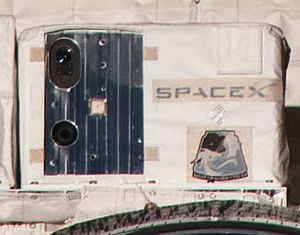
In 2005, NASA looked for companies to build new cargo vehicles for the ISS. This was because the Space Shuttle was going to stop flying soon. SpaceX offered their Dragon capsule as part of their plan to NASA in 2006.
On August 18, 2006, NASA chose SpaceX and another company to develop these cargo services. The plan was for SpaceX to do three test flights with the Dragon between 2008 and 2010. SpaceX was set to receive money if they met NASA's goals.
Delivering Supplies: Commercial Resupply Services
On December 23, 2008, NASA gave SpaceX a big contract worth $1.6 billion. This contract, called Commercial Resupply Services (CRS-1), asked for 12 flights. These flights would carry at least 20,000 kilograms (44,000 lb) of cargo to the ISS.
SpaceX made sure the Dragon was ready for space. In February 2009, they tested its special heat shield, called PICA-X. This shield protects the capsule when it comes back to Earth. The Dragon also had a special sensor called DragonEye. It was tested on the Space Shuttle Endeavour in 2009 to help Dragon get close to the ISS safely.
NASA also made sure the Dragon was safe from space radiation. The Dragon's computers were designed to be very reliable. They had a "triple redundant" system, meaning there were three of everything. This way, if one part failed, the others could take over.
Later, NASA added more missions to the CRS-1 contract. This included flights like SpaceX CRS-13, SpaceX CRS-14, and SpaceX CRS-15. More missions were added, bringing the total to 20 flights.
New Contracts: Commercial Resupply Services Phase 2
In January 2016, NASA signed new contracts for cargo delivery, called CRS-2. SpaceX was one of the companies chosen. These new missions are planned until at least 2024.
Test Flights: How Dragon Proved Itself
The first flight of the Falcon 9 rocket in June 2010 carried a basic version of the Dragon capsule. This unit helped test the capsule's systems and collect data during launch. It was not meant to survive coming back to Earth.
NASA asked SpaceX for two main test flights for the Dragon. The first Dragon spacecraft launched on December 8, 2010. It successfully returned to Earth's atmosphere and was recovered. This was also the second flight for the Falcon 9 rocket.
The second Dragon flight launched on May 22, 2012. Dragon performed tests in orbit and then connected with the ISS on May 25, 2012. It delivered its cargo and then returned to Earth on May 31, 2012. It landed safely in the Pacific Ocean and was recovered.
After these successful tests, NASA announced in August 2012 that SpaceX could begin regular cargo missions to the ISS.
Bringing Science Home: Returning Materials from Orbit
The Dragon spacecraft is special because it can bring a lot of cargo back to Earth. It can return up to 3,500 kilograms (7,700 lb) of cargo. This includes important science experiments and materials from the ISS. Other than the Russian Soyuz crew capsule, Dragon was the only spacecraft that could survive re-entry and bring things back.
Because Dragon could return materials quickly, sometimes in just 48 hours, it helped scientists. They could do experiments on the ISS and then study the results on Earth with special tools. For example, one mission brought back mice that had been in space. This helped scientists learn how being in microgravity affects blood vessels and how arthritis develops.
Regular Flights: Operational Missions
The Dragon launched its first regular cargo flight on October 8, 2012. It completed the mission successfully. NASA first ordered 12 missions, then added 8 more, making a total of 20 flights until 2019. In 2016, SpaceX was given 6 more missions under the CRS-2 contract, scheduled from 2020 to 2024.
Reusing Spacecraft: A Big Step
CRS-11, launched on June 3, 2017, was a big moment. It was the first time a Dragon capsule that had flown before was used again. This capsule, C106, had flown in September 2014. This mission delivered over 2,700 kilograms of cargo to the ISS. Reusing spacecraft helps save money and resources.
CRS-12, launched on August 14, 2017, was the last flight of a newly built Dragon capsule. All future missions would use refurbished spacecraft.
CRS-13, launched on December 15, 2017, was another important flight. It was the second time a Dragon capsule was reused. It was also the first time a reused Dragon flew with a reused Falcon 9 rocket booster. This mission delivered cargo to the ISS and then returned to Earth. It was the first space capsule to be flown to orbit more than once.
Many later missions, including CRS-14, CRS-15, CRS-16, CRS-17, CRS-18, CRS-19, and CRS-20, all used Dragon capsules that had flown before.
Developing a Crewed Version
In 2006, Elon Musk said SpaceX had built a test version of a crew capsule. This included a system to keep astronauts alive for 30 days. SpaceX also released a video in 2011 showing how the escape system would work if there was a problem during launch. SpaceX worked with the U.S. Government on contracts to develop the Dragon 2 for carrying people.
How Dragon Was Built
In 2010, SpaceX was building one new Dragon spacecraft and Falcon 9 rocket every three months. Elon Musk wanted to make one Dragon every six weeks by 2012. The spacecraft used many composite materials to make it lighter and stronger.
By September 2013, SpaceX had a huge factory. They were building six Dragon capsules at different stages of production. This included the next four Dragons for NASA's cargo missions.
Dragon's Design
The Dragon spacecraft had three main parts:
- A nose cap.
- A main capsule that looked like a blunt cone. This is where the cargo was kept.
- A trunk section at the back with solar panels. This part carried unpressurized cargo.
The capsule had a special heat shield called PICA-X. This shield protected the capsule from the extreme heat when it came back into Earth's atmosphere. The Dragon capsule itself could be reused for many missions. The trunk, however, was not reused. It separated from the capsule before re-entry and burned up in the atmosphere. The trunk also carried the spacecraft's solar panels, which made power.
The Dragon was launched on top of a Falcon 9 rocket. The capsule had 16 small engines called Draco thrusters. After its missions, the Dragon capsule would land in the Pacific Ocean. Ships would then bring it back to shore.
When the Dragon arrived at the ISS, the station's robotic arm, Canadarm2, would grab it. Then, it would attach the Dragon to the station. The cargo Dragon did not have its own air system for astronauts. Instead, it used fresh air from the ISS. Dragon usually stayed connected to the ISS for about 30 days.
The Dragon capsule could carry up to 3,310 kilograms (7,300 lb) of cargo. This could be all inside the pressurized part, all in the unpressurized trunk, or a mix. It could also bring back up to 3,310 kilograms (7,300 lb) of cargo to Earth.
Starting with the fifth Dragon flight in March 2014, the design was updated. The outside looked the same, but the inside parts were changed. This allowed the Dragon to provide more electricity to powered cargo, like special freezers for science experiments.
Dragon Family: Other Versions
DragonLab
SpaceX had plans for a version of the Dragon called DragonLab. This would be a free-flying spacecraft for science experiments. It would have its own power, control systems, and communication tools. It could carry up to 6,000 kilograms (13,000 lb) of cargo into space and bring back up to 3,000 kilograms (6,600 lb) to Earth. However, these missions were later removed from SpaceX's plans.
Dragon 2: For Crew and Cargo
A newer version of Dragon, called SpaceX Dragon 2, was built to carry people. It can carry up to seven astronauts, or a mix of crew and cargo, to and from low Earth orbit. The Dragon 2's heat shield is even stronger. It can handle coming back to Earth from missions to the Moon or Mars. NASA helped fund the development of the Dragon 2 for carrying astronauts. The cargo version of Dragon 2 is now used for the CRS-2 missions.
Images for kids
See also
 In Spanish: SpaceX Dragon para niños
In Spanish: SpaceX Dragon para niños


